 The newspaper was handed to me over a plate of fish and chips with loose peas at the Coffee Pot in Stornoway on the Isle of Lewis. “Dredging row turns bitter as ban ‘broken’” was the headline of The Press and Journal.[1]
The newspaper was handed to me over a plate of fish and chips with loose peas at the Coffee Pot in Stornoway on the Isle of Lewis. “Dredging row turns bitter as ban ‘broken’” was the headline of The Press and Journal.[1]
The “bitter row” had broken out about a week earlier and turned more bitter about 38 hours earlier in the evening when the Scottish Parliament came to Ullapool. Ullapool is the fishing town in Wester Ross, north of Skye. It is so high in the Highlands that the ferry from the North, from the Isle of Lewis, connects to Scotland at Ullapool.
I had boarded a ferry in Ullapool to cross over the waves to the Isle of Lewis. More than the destination, I was interested in the essential fish habitats passing beneath the boat. We were crossing the undersea realms of king scallops. For the conflict was all about the pursuit of king scallops by two opposing groups, the scallop dredgers versus the scallop divers. Compounding problems, separate alliances had been built from these two small commercial fishing operations, and the resource dispute had turned bitter.
 I am executive director of the Ocean River Institute. We provide individuals and groups with specific opportunities to make a difference protecting ecosystems and saving wildlife. I had been in Glasgow the previous summer to present a paper on American fisheries at the Society for Conservation Biology’s International Marine Conservation Congress. I had returned to Scotland at the invitation of Sea Change, a community advocacy group based in Ullapool. Sea Change links up with other West Coast of Scotland voices, including scallop divers, who share a common goal to protect Scotland’s Inshore Marine Protected Areas. As a champion for essential fish habitats, there would be no doubt which side of the king scallop conflict I was on.
I am executive director of the Ocean River Institute. We provide individuals and groups with specific opportunities to make a difference protecting ecosystems and saving wildlife. I had been in Glasgow the previous summer to present a paper on American fisheries at the Society for Conservation Biology’s International Marine Conservation Congress. I had returned to Scotland at the invitation of Sea Change, a community advocacy group based in Ullapool. Sea Change links up with other West Coast of Scotland voices, including scallop divers, who share a common goal to protect Scotland’s Inshore Marine Protected Areas. As a champion for essential fish habitats, there would be no doubt which side of the king scallop conflict I was on.
Traditionally, the scallop dredgers worked the broad central areas of the sea loch. Scallop divers worked the margins close to shore. Much of the loch, away from the edges and backwaters, is better for scallops with sandy seafloor swept clear of finer sediments by tides and currents. For decades the dredgers have swept these areas systematically like a home-owner pacing a lawn mower to cut all the grass. The scallop dredge is nothing like the traditional trawl that rolls a chain along the bottom. Instead, scallop fishermen use a box trawl with rigid bar gouging sand and capable of breaking rock. Spikes are affixed to the dredging bar downwards to dig and flip the scallops out of the sandy sea floor up into the back of the dredge. The scallop dredgers, having over-fished and exhausted the center portions of the Loch, now work the margins where rocky formations and gravel-boulder reefs harbor swales of sand and plains of mud.
Scotland’s ocean floor is a patch work of seascapes, a quilt of essential fish habitats. The basic four habitats are sand, mud, gravel and boulder reefs. Scallops burrow in sand. Muddy ocean floors are home to Acadian redfish, sold as “ocean perch.” Gravel beds are preferred by cod, haddock, pollock and hake. Boulder reefs are where wolfish den.
Beyond the basic bottom habitats, Scotland’s underwater realms boarder on the fantastic with wonderful specificity: eelgrass beds, lush kelp forests, burrowed mud habitat, flame shell beds, northern feather star aggregations, coarse shell gravel with burrowing sea cucumbers, and maerl beds.
A maerl bed is not a coral reef. Instead maerl is composed of three species of coralline algae. The maerl form of red algae is distinctive for its calcareous deposits within the cell walls. Often having a pink color. Maerl beds host likely the greatest diversity of marine life of any Scottish undersea habitat and serves as a nursery for cod and pollack.
The aim of the Wester Ross Marine Protected Area is to recover the maerl beds and flame shell beds, and to conserve the other undersea habitats. Scotland has the greatest number of Marine Protected Areas in Europe and likely the world. Thirty were designated in 2014. Topping the list of national treasurers are maerl beds because Scotland is the last refuge harboring many of the most extensive maerl beds in Europe.
Sea Change, the Ullapool-based advocacy group, brought the plight of Scottish maerl beds in general and specifically king scallops to my attention by forwarding a letter from a scallop diver.
The diver was familiar with the MPA’s seascape having scuba-dove there four years prior. Then he swam down from his small skiff past kelp forest to boulder reef and on down to patches of sand strewn between the rocky outcrops far from the center of the sea loch. This time the seascape had been “physically altered.” The kelp “was lying, torn and limp on the seabed.” The rocky reefs “were lower and the boulders which comprised them had been extensively scattered.” “Scallops were in some cases fatally injured with chunks of shell and skirt torn out and in others completely smashed.” “It was heartbreaking.”
The scallop diver dove seven times in the area. Everywhere were “smashed urchin, scallop and crab, ripped up kelp, torn and dying anemones . . . It was soul destroying.”
The diver moved to a different area where the previous summer “the ground was recovering and looking in good shape.” Not so this time. “it had been dredged heavily. . . I was moved to the point of tears by what I saw there.”
This place had been “ruined beyond recognition with the ‘ploughed field’ scenario heavily evident.”
Worst still, the partially recovered maerl beds the diver had observed last year were destroyed with “[s]tone and boulders ripped up from under the sand/maerl and fully exposed creating a Martian like surface.”
One scallop diver’s passionate observations made our king scallop campaign possible. Just as the prospect of silent springs was stopped by the writings of Rachel Carson, the threat of shredded seafloors could be stopped by the writings of another individual.
The gleaming white houses with black roofs of Ullapool marched out in straight lines along a south facing shore that juts out into Loch Broom. There is an orderliness to the buildings that differs from the crush of habitations of most seaport towns. This is a herring port built deliberatively by the British Fisheries Society in 1788.
In Scotland the Herring Boom peaked in 1907 when 250,000 tons or 2,500,000 barrels were cured and exported. In 1913 there were 10,000 Scottish boats fishing for herring. Numbers of fish and boats declined into World War II. After the war the herring were gone from Scottish waters.
Ullapool on Loch Broom is a place of contradictions and conflict. To the southwest rising more than 3,000 feet a complex mountain massif commands the landscape. Soft red and brown Torridonian sandstone tops hard Lewisian gneiss. It is called An Teallach, which is Scottish Gaelic for “The Anvil” or “the Forge.” The ten peaks of the massif are sharp and steeply sided as the sandstone crumbles away over time.
To the northeast of Ullapool, the landscape is lifted by gray cliffs, thrust faults, made of ancient metamorphic granitic gneisses of the Lewisian complex. Victorians noted that these rocky outcrops were remarkably similar in stone to the granitic landscapes of Newfoundland, New Brunswick and New England. A number of observations were made here that led to the development of the concept of plate tectonics and colliding continents.
Torbay palms stand along the streets of Ullapool. These stout trees bearing clusters of sword-like leaves were the last plants I expected to see on the northwest coast of Scotland. The branched monocot trees are refugees from New Zealand where they are known as cabbage trees. They are able to shelter and thrive here, and not on the Isle of Skye, because the Gulf Stream from America warms these more northerly shores.
The Glaswegian actor Rory McCann is reported to keep his sailboat in or near Ullapool. I wrote to his agent and asked if the actor who plays The Hound in Game of Thrones would do a one-minute spot in defense of king scallops. McCann was otherwise engaged. I like to think the wanderer who said “Home for me is my boat, really,” was not at home at the moment in Wester Ross, a land that inspired Game of Thrones author George R.R. Martin.
I arrived in Ullapool about five in the evening expecting to meet the community group Sea Change. Instead, I received a message that the Scottish Parliament was in town and I was to precede directly to the high school for a six o’clock meeting. I walked a few blocks down the street from my bed and breakfast house. Ullapool High School is on the east side of town. Serving a population of only 1,500 residents, the school seemed large. Setback from the tree-lined road for fields and parking, the building was light gray with steep dark gray gabled roofs. Wide foyer fronted an auditorium of about 200 seats. On the stage a dozen wing-back chairs where arranged in two arches so that backrow chairs had a view between chairs in the front row.
Seven men and six women about my age dressed in black suits walked up onto the stage. The Deputy First Minister, a gentleman with gray hair, stood tall behind the podium while the rest took their seats. The First Minister was absent but the rest of the ministry had traveled over the Highlands to far-flung Ullapool.
Deputy First Minister welcomed the public. He explained we would have an hour long question-and-answer period. Three questions would be taken at a time. He would assign the appropriate minister to answer. Should questions not get addressed or adequately answered, we were invited to join the ministers for tea immediately following outside of the auditorium. I was impressed and pleased by the civility of this government meeting. In America, whenever government stood before the public it was usually called a hearing with citizens complaining and officials not responding. I have often felt bruised and battered by the conflicts inherent to such meetings.
There were good questions for the Ministers of Health, Roads, Education and Higher Education. Finally, a member of Sea Change stood and asked the Cabinet Secretary for Environment, Climate Change and Land Reform, Richard Lochhead, the question that would make made the news in Lewis. “Will you act to stop illegal scallop dredging within the Wester Ross MPA?”
“I am well aware of the complaint,” said Minister Lochhead. “If the evidence is conclusive, I will bring forward emergency orders to close areas immediately and not wait until November.”
At the tea reception that followed, I met Cabinet Secretary Lochhead and presented him with our 47 page bound letter of 2,429 signatures complete with hundreds of comments.
The Minister was most impressed and pleased that so many had taken the time to write from so far away with expressions of concern for Scotland’s ocean floor habitat essential for king scallops. He was particularly interested in comments from individuals claiming ancestral family connections to Scotland. The Scottish diaspora is an issue very alive in local minds and media.
The turning of Scottish citizens off the land to make a profit was evident in the newspaper that the Coffee Pot server kindly let me keep despite my offer to purchase it. The coffee was included with fish and chips, too. Any diner that includes both coffee and newspaper free of charge is participating in a most civilized society. Not so civil was the tone of the newspaper based in Aberdeen, home of the Scottish Fishermen’s Federation. It quoted the Scallop Association’s secretary:
“A good nor’westerly storm will cause as much if not more damage than all the fishing effort.”
The scallop dredger’s completely false statement only has currency because what happens beneath the waves is unknown to most people. Instead they know shores were much flotsam and jetsam is strewn about.
“What people seem to want is the continued gentrification of the Highlands. People now see it as a plaything, a playground.”
“They want to preserve a Nirvana that is dependent on one or two bits of eco-tourism. I find that extremely disquieting.”
The newspaper is clearly biased in its disrespect and total disregard of scallop divers and prawn fishermen, as well as the majority of residents who want the ocean floor protected and long for the return of marine wildlife.
“The scallop association’s chairman has likened the “attack” on his industry to a modern day Highland Clearances. In a direct comparison with the tragedy of the 18th and 19th century clearances, in which rich lairds evicted tenants to make way for mass-scale sheep farming, he said he believed today’s environmental push is no less destructive. . . It’s proponents are as blinkered as their predecessors in their single-minded pursuit of their goals and opinions and feelings of local communities seem to be of little import.”
About a week earlier BBC News reported Bertie Armstrong, the Scottish Fishermen Federation’s chief executive, speaking in no less dire terms: “It could be, and I’m choosing my words carefully here, devastating.”
“If you want to take a local community and result in a clearance, this is the right way to go about it.”
“If you take down small businesses when there’s only a small number there, then you will devastate a community.”
Contrary to the stated beliefs, less than 2% of Scotland’s coastal waters are to be closed to scallop dredging. The large sandy plains in the middle of bays and lochs will still be scoured by scallop dredgers, as they have for decades.
In contrast, the Clearances devastated communities completely throughout the Highlands in efforts to make a profit grazing sheep at the expense of the people, their stewardship and ecological balance.
I had come to Scotland expecting significant rhetorical push-back. It was not surprising for the fishing industry to make statements that had no relation to the destruction of essential fish habitats, loss of ocean floor ecosystems and the decimation of king scallop populations caused by scallop dredges. With conflicts between two ocean user groups in the waters off Wester Ross, they spoke about the land. I was dismayed by the class-warfare language with references to an action of Scotland’s greatest shame, the Clearances.
Alistair Sinclair of the Scottish Creel Fishermen’s Federation likened the Ocean River Institute to the cavalry coming to the rescue because I brought passionate comments from hundreds of individuals, residing in all fifty American states. Instead of one learned-voice, a cacophony of voices was brought to bear on the problem. Two thousand four hundred twenty-nine individuals took the time to sign my letter with complete contact information, to champion the king scallops of Wester Ross.
Alistair Sinclair, the National Coordinator of the Scottish Creel Fishermen’s Federation, explained it to me in Inveraray. We talked over lunch in the restaurant where Alistair’s wife Maggie works. The haddock was very fresh and the filet covered the large plate, crowding the chips onto the margins. The proprietor gifted me a malt, a neat serving of Lagavulin, the amber essence of Scotland.
“The reason we are where we are today is the fact that we have had poor governance,” Alistair explained. “I am glad to say that Richard Lochhead and Marine Scotland have actually grasped the nettle. They’ve decided there has to be a change here if there’s to be a future for guys like the two lads who work my boat.”
Alistair then drove us to his home in the nearby smaller town of Furnace. We talked fish and fishing on his back porch overlooking Loch Fyne. The Arrochar Alps loomed bright in the distance. Shadows climbed hillsides of fields and forest. Looking out on the sea we saw “the two lads who work my boat” motor to mooring Alistair’s small red boat with white flag of a wheel-house at the front.
Creel fishermen fish for prawns with netted baskets called “creels.” Once, creels were rounded half-spherical pots with a flat bottom. Today, they have a rectangular base with netting raised by three hooped struts, very similar to a half-sized New England lobster pot. Like a lobster pot, the creel has a one-way opening on one side of the central hoop, while the other half is netting stretched between hoops. And, like a lobster pot, creel pots are rectangular and may be stacked at the back of the boat ready for easy deployment.
The two creel fishermen came ashore and we gathered around a picnic table with cups of coffee. Later, Alistair’s small open blue boat was returned by two anglers. Our gathering of four on Alistair’s back deck became six of us, and the coffee flowed freely. The anglers recalled fishing years ago when 13 species of fish could be caught in this Loch. Now, there are mostly four species – mackerel, hake, flounder and pollock.
Today had been a very good day. The two anglers caught and released a number of fish, including a large haddock close-by the farmed salmon pens. The pens may be a place where more than salmon benefit from the feeding of high protein fish pellets. Near the salmon pens were seen cod, haddock, hake and pollock. The young fish swim into the salmon cages where they grow and become trapped. These fish are sold to market by the salmon farmers, much to the consternation of all on Alistair’s deck.
Alistair was not pleased with the location of the salmon pens in Loch Fyne. He believes they are located on top of the best fish nursery places. It never occurred to me with so much ocean all about that the loch that salmon pens could be preventing fish access to their natal habitats and nurseries. However, this would explain why fish that occupy the sea floor called demersal fish (hake, pollock, haddock and cod) were found in and near the pens, and not the more abundant mackerel, a member of the order of tuna fish. If it were only excessive salmon-feed the swift-swimming mackerel would have been there.
Recently a scallop dredger pulled up some of Alistair’s creels. Pots and gear were hoisted above the deck for Alistair to see from a distance. They sold sell the creels for cash. This was spit-in-your-face personal. How dare Alistair, a creeler, speak out against a dredger?
This I-mind-my-business, you-mind-yours argument breaks down when dredgers work waters outside of their prime scallop waters and into the waters worked by many others. The scallop dredgers further irritate all other local users by acting as if they speak for all fishermen, if not all Scotsmen. They make nonsensical statements to the media of them the local working class versus the rich and governmental.
“If they take away our winter grounds, we’ll be forced out into areas which are more exposed. The way the Scottish government is going with the MPAs and listening to the anti-fishing lobby, I think we’ll see funerals before someone changes their mind.”
The areas more exposed that dredgers will be forced into is the middle of the Loch, the winter grounds taken away are the edges that do not have prime king scallop sandy ocean floors. Sitting with three creelers and two anglers, I looked the all of one mile across Loch Fyne, Scotland’s longest sea loch of 40 miles long. With increased exclusion what dredgers would be forced to suffer did not seem so bad. They’d have to fish a half mile out instead of a quarter mile or less. Okay, in fairness the widest section of Loch Fyne is near its mouth at Tarbert where the opposing shore is four miles away. But the Marine Protected Area is just the upper reaches before us. So many outcries over the closing of so little water, less than 2% of Scotland’s scallop waters.
Alistair has the courage to stand up for the creelers. The trouble for the dredgers is that he is well known in fishing communities, has a strong blue-collar Scottish accent, and works a boat that is smaller than any dredger. (Scallop dredgers are in turn smaller than other trawlers.) The BBC news crew had a field day, two days before my visit. Out on his creel boat, the newsmen put a familiar face and voice of reason to the dredging ban issue.
Fishery conflicts are not new to Loch Fyne. In 1833, the new trawl-net fishermen usurped the traditional drift-net fishermen. Soon the famous Loch Fyne Kipper was a memory. Modern technology replaced traditional fishermen. Then the shoals of herring were gone. Fish in the lochs were gone before the foreign fleets arrived because government never managed their own, never as Alistair aptly said to the BBC “grasped the nettle.”
Despite the challenges, I found good cause for hope for the fisheries and the ecosystems. There is a prosperous oyster fishery. The locally-owned Loch Fyne Oysters serves oysters that were to my taste as briny and fine as the best of Massachusetts. Here waters flowing out of the Highlands and ocean waters are relatively clean. With vast beds of filtering oysters, the waters are becoming even cleaner with every bivalve mollusk. Loch Fyne has always been popular with anglers; more recently it has become a destination for sport diving as well. Local economies are on the up.
Another Marine Protected Area is in the Sound of Mull. This is arguably the best place for scallops in Scotland thanks to the strong currents. Guy Greive of the Ethical Shellfish Company explained standing on a dock half way up the Sound on the Isle of Mull. The Sound is about three miles wide by twenty-five miles long. Guy pointed out the dredging closure line across the Sound. It seemed to me to extend right from the dock perpendicular to the shore directly across. To our right, scallop dredging would be banned, while to the left of apparently equal distance scallop dredging could continue unfettered. The open-to-dredging portion of the Sound conveniently includes Tobermory, Mull’s best harbor and largest community.
As a diver, Guy was shocked to see large sections of the seabed reduced to rubble by scallop dredging. Complex benthic habitats were completely destroyed. Guy responded by creating a hand-dive scallop company that pledges to support sustainable fishing methods and to contribute towards the recovery of Scotland’s ocean marine life. Many said such a company could not be. Guy did not listen. With much resourcefulness, sagacity, and for me jaw-dropping determination, he went about the business of scallop diving.
The business began with Guy, Juliet and their two sons camping out in a friend’s backyard. Guy drove to Tobermory where his small boat with outboard enginge was moored. Each day began with a swim out to the boat. The boat was then brought to dock to load brother and gear. On site, Guy dove down past kelp forests to deeper waters where rocky outcrops gave way to areas of sand. Buried beneath sand, the scallops were invisible. A dimple in the sand gave a clue to where hides the scallop. Guy reached into the sand to pluck a single scallop and put into the net bag. “Sometimes they are like castanets that pop up and flip around when you try to catch them.”
Returning to port, Guy unloaded catch, gear and brother on to the pier. Moored his boat and swam ashore. Grabbing a bite to eat, Guy then drove 14 hours to deliver the freshest possible scallops to London. Fortunately for this startup business, London’s finest establishments really liked the scallops. Guy’s business grew from humble beginnings. In 2014, Ethical Shellfish Company was recognized with a national award, Considerate UK Food Supplier of the Year. Today, the company employs about two dozen, including divers and drivers.
The King scallop is second only to prawns as the most valuable shellfish species in Scotland. These scallops are larger, about twice the size, of the two kinds found in American waters, bay and sea scallops. King scallops spawn for the first time during their second year in the fall. Scallops grow in annual spurts. During the winter months there is nearly no growth and this portion of the shell becomes a dark ring. Counting rings, it looked to me that it takes about 8 to 10 years for scallops to be ready for market. King scallops live for 20 years or more. After ten years, growth slow and on the shell spacing between the rings diminish.
On the day I met Guy, he drove us out to the Ethical Shellfish Company. Beneath the dock were mesh bags of scallops. He pulled up a red bag full of scallops, each about seven inches in diameter. He selected four for me and three for himself, deftly opened and cleaned. He left only the meat of the scallop on a single shell and placed them into a cardboard box. “We never use Styrofoam,” explained Guy, “except for one customer but we’re working on him.” We climbed into Guy’s pickup truck and drove a couple of miles to his home.
I met Juliet and their two sons, it being a Saturday. The scallops were sautéed in butter and plated on the kitchen table before me in a flash. King scallops are not as sweet as bay scallops with a more pleasing firmness and complex subtle flavors. They were absolutely delicious. I could understand why hand dived scallops on menus in Scotland rivaled the cost of lobster dinners on menus in Massachusetts. Guy proudly recounted to Juliet our verbal exchange over the net bag full of scallops when offered three, “He said four would be better!”
With market appetite growing for fluted gold lying about on Scotland’s ocean floors, government must step up to enforce regulations that sustain both scallops and fishermen. Much has been done to identify what is living in the margins that the scallop dredges must not disturb or destroy. Government should ban scallop dredging to protect specific places of maerl beds, kelp forests, rocky ledges and gravel/boulder reefs. Government must act to protect nurseries for herring and cod. Sandy swales between the other rocky and muddy habits provide refuge from which scallops can repopulate overfished areas, such as the center portions of Loch Fyne or the eastern half of the Sound of Mull.
Seeing the damage done by scallop dredgers to maerl beds and rocky ledges, as well as turning kelp forests into tilled sands, makes clear the need for government intervention. The “row” in the media comes down to the micro-management of less than 2% of Scotland’s waters. The row is bitter because one group views it all about one animal, the King scallop and their access to it. Most everyone else views it as saving dear places to restore healthy ocean benthic ecosystem, rocky, gravely, sandy and muddy areas. For most people, local inhabitants and visitors alike, this is about protecting a much beloved quality of life and an awesome diversity of wildlife.
Despite the challenges, I found good cause for hope for the fisheries and the ecosystems. There is a prosperous oyster fishery. The locally-owned Loch Fyne Oysters serves oysters as fine as the best of Massachusetts. Here waters flowing out of the Highlands and ocean waters are relatively clean. With vast beds of filtering oysters, the waters are becoming even cleaner with every shellfish. Loch Fyne has always been popular with anglers; more recently it has become a destination for sport diving as well. Local economies are on the up.
Five days after I met the Cabinet Secretary in Ullapool, he acted. The evidence was conclusive that one scallop dredger had worked a protected area damaging mearl beds. A Marine Conservation Order (MCO) was issued to prohibit all forms of scallop dredging in the Wester Ross MPA as of midnight August 16, 2015. This was the second time these powers in the Marine (Scotland) Act 2010 have been used. Essential habitats of burrowed mud, flame shell beds, maerl beds and northern feather star aggregations are now protected in the waters of the Summer Isles, past Ullapool west to Grunard Bay, to include Loch Ewe.
Had I spent a lifetime on the craggy shores and rollicking waves of Scotland, I would never have come to know the marine life, the wildness and the wonder as well as I did due to the people of this place. They looked, inquired, and took the time to put their observations in order to share their thoughts and treasures with others.
[1] Ramage, I. (2015, August 15). Dredging row turns bitter as ban broken. The Press and Journal Highlands & Islands, page 1, 5.
[2] Ramage, I. (2015, August 15). Dredging row turns bitter as ban broken. The Press and Journal Highlands & Islands, page 1, 5.
[3] Kirkaldy, L. (2015, August 17). Scottish Government introduces urgent Marine Conservation Order (MCO) off coast of Wester Ross. Retrieved August 26, 2015, from Holyrood: https://www.holyrood.com/articles/news/scottish-government-introduces-urgent-marine-conservation-order-mco-coast-wester-ross
[4] Miller, D. (2015, Aug 6). Concern over Scottish marine protected areas. Retrieved Sept 3, 2015, from BBC News: http://www.bbc.com/news/uk-scotland-33797254



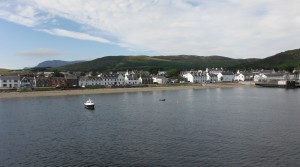
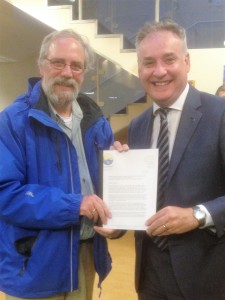
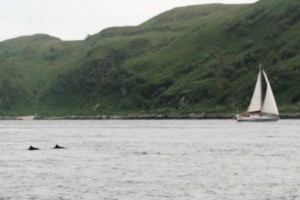
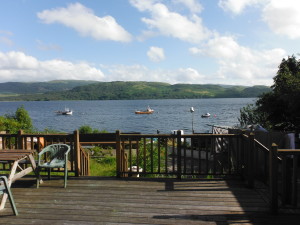

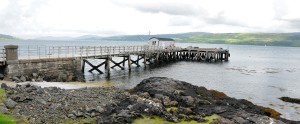
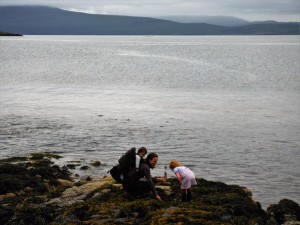
When crossing the Bridge Over the Atlantic it is vital you know which side you are on. The south side, to the right of the picture, is where kilts are forbidden and only pants my be worn. On the north side, from where I take the photograph, is a very small house where Scots take off their pants and put on their kilts. Lucky for you in this photo you can’t tell what stage of dress or undress I am in. Unlike my ancestors, I will not be caught going regimental.
I ate the King scallops without taking the King’s schilling in Scotland. Now back in Massachusetts when its a daily special I’ll have the scallops. Our scallops are sweet and delicious but the King scallops have a bit more flavor, a rich complexity, that you won’t miss if you haven’t tasted it. Outside of Caledonia, I prefer sea fish and clams to scallops. At Summer Shack, I had the most delicious Loch Etieve sea trout all the way from Scotland. You know about salmon from Scotland – try the sea trout.
“Beyond the basic bottom habitats, Scotland’s underwater realms boarder on the fantastic with wonderful specificity: eelgrass beds, lush kelp forests, burrowed mud habitat, flame shell beds, northern feather star aggregations, coarse shell gravel with burrowing sea cucumbers, and maerl beds”